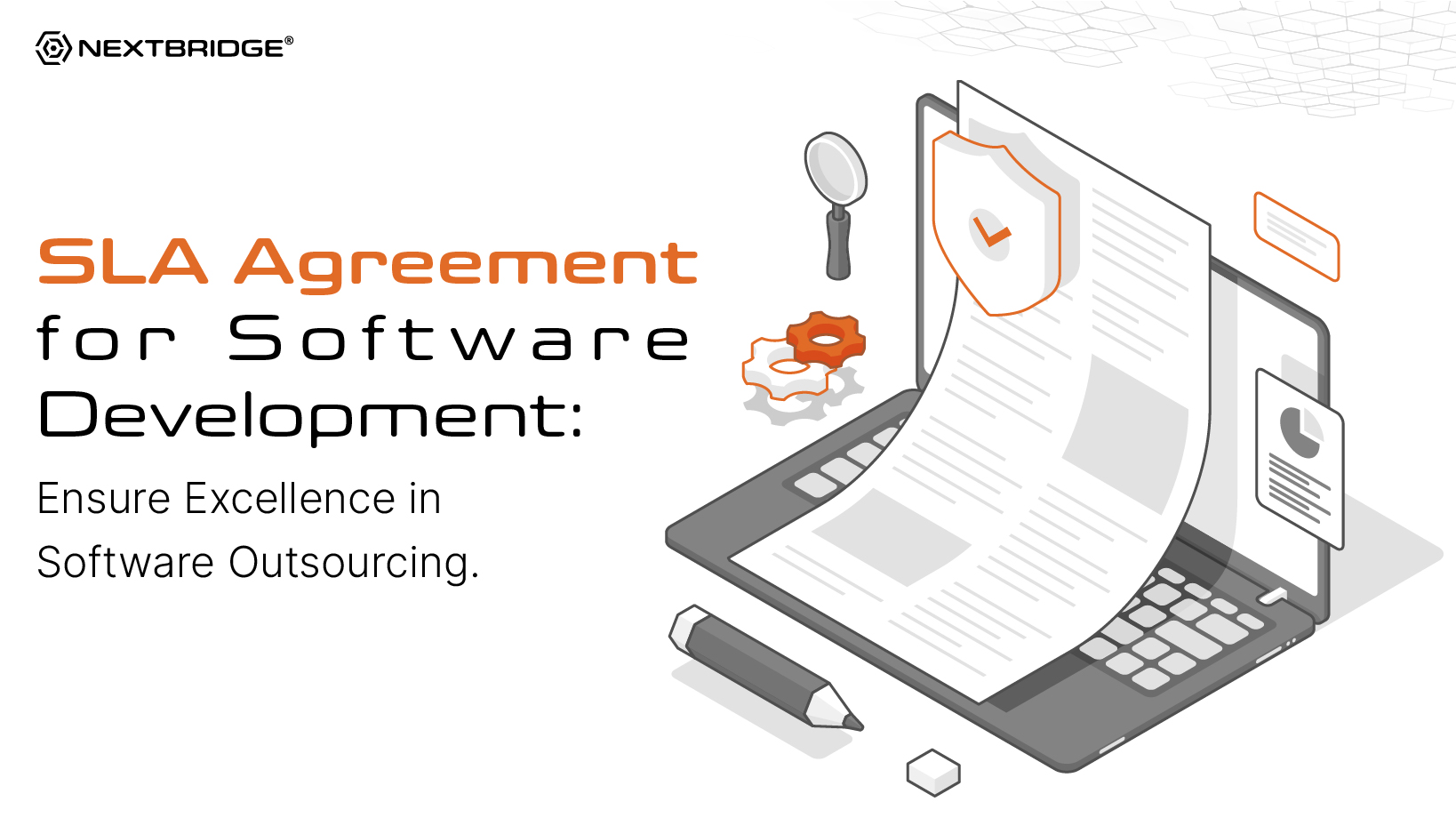 Back to all articles
Back to all articles
Blogs
SLA Agreement for Software Development: Ensure Excellence in Software Outsourcing


You, being a business owner in the software industry, might have heard about the SLA Agreement. Many people like you have likely heard about it, but not everyone is aware of its underlying significance. The fact is, SLA stands for Service Level Agreement, and acts as
guiding principles to ensure that the partnership between clients and service providers is smooth and beneficial.
Whether you need SaaS, consulting, IT, or support outsourcing services, you need to have a deep understanding of an SLA document that builds trust among both parties. An experienced outsourcing firm knows the importance of service level agreements and ensures that it develops long-lasting relationships with its clients.
This blog will define SLA, discuss its importance for software services, explain why it is required for remote developers, and more.
SLA Meaning in Business
A service-level agreement or SLA full form in company operations means a documented contract between a service provider and the customers that outlines what services the business will provide and in what ways. An SLA contract also features all the service standards the business is required to meet.
So, what does SLA stand for in business? Simply put, it is a contract that ensures both the service providers and the clients are on the same page before they initiate a collaboration by agreeing to measurable standards.
Businesses integrate multiple internal service level agreement documents into their operations, allowing them to create and maintain collaborative partnerships with clients and other business owners. A software partner with the most reliable services ensures that every SLA it documents aligns perfectly with the business goals of its clients.
Why a Software Service Level Agreement Matters to You?
The use of an SLA agreement is widespread in the software industry as it provides security to the clients. Both the service providers and the customers require an IT service level agreement before they make a final deal.
An SLA agreement provides a guarantee to you that the outsourcing firm will meet high service standards, meet expectations effectively, and understand responsibilities and liabilities. In addition to this, SLA in software services outlines assistance and problem-solving frameworks for you.
SLA in IT helps you by highlighting performance requirements that the service provider is expected to meet. These requirements allow you to compare multiple providers and choose the one that suits you the best. In short, an SLA agreement clarifies what you can expect from the software development company and what the results would be while working with it.
As a trusted development company, we ensure that our SLA brings no empty promises but measurable outcomes.
Benefits of an SLA Agreement in the Software Industry
An SLA agreement in the software industry is essential as it provides a clear framework explaining the roles and responsibilities of a service provider and a client. It reduces the risk of potential conflicts and uncertainties and sets the overall expectations related to the project. It is a structured approach that smoothens the execution of the project and the desired outcomes.
An SLA agreement is beneficial for both parties in the following ways:
- Creates Accountability
Through an SLA agreement, both parties develop obligations and responsibilities towards each other and eventually ensure accountability.
- Provides Customer Experience
All the benchmarks and standards mentioned in an SLA document reflect that the service provider will ensure customer satisfaction.
- Ensures Conflict Resolution
With predefined procedures and frameworks to address and resolve conflicts, an SLA agreement helps avoid conflict between both parties as soon as the problem arises.
- Offers Legal Protection
An SLA contract, due to its nature, provides and ensures legal security to both parties. It has a list of conditions, dispute mitigation processes, clear expectations, and responsibilities towards both parties.
- Clarifies Expectations
A service level agreement clearly defines services, validation metrics, and performance standards. This clarification assures customers of a specific service level, guarantees corrective measures in case obligations are not met, and helps vendors understand SLA expectations they should meet.

SLA Requirements for Remote Developers
Before you choose an outsourcing firm, you must ensure that the remote development teams meet the SLA requirements that meet your expectations, maintain communication, and ensure project quality for success.
Look for the following before agreeing to an SLA Agreement:
| SLA Requirements | Description |
| Definitions of service | A list of actions necessary to deliver requirements successfully. |
| Performance Metrics | Definitions of key parameters that make project completion successful (resource utilization, response time, and uptime). |
| Responsibilities | A summary of the service provider’s main tasks and the client’s duties. |
| Availability of the service | Definitions that explain a service’s expected availability and metrics. |
| Communication protocols | Explanation of how the changes and issues occurred during the project will be handled. |
| Service levels | Requirements to meet expected service levels. |
| Incentives and Penalties | Description of rewards in case of exceeding service levels and consequences of failure in service delivery. |
| Limitations/exclusions | Clarification on those project aspects where service levels are limited or have no applications. |
| Dispute resolution followed by escalation methods | An action plan to resolve misunderstandings and a list of measures for escalation of the project. |
| Resolution or response time | An outline that features a timeline in which the clarifications for any service requests and incidents will be provided. |
More service level agreement requirements to look for:
- Limits for memory and CPU usage during peak times to ensure the responsiveness of applications and minimize the risk of crashes.
- Methods to identify performance issues by tracking the server's load and response times.
- Channels for interaction and integrating communication through tools like Microsoft Teams and Slack to support real-time interaction.
- Utilization of tools like Trello and Jira for SLA project management and tracking tasks.
- Presence of NDA augmented staff clauses in service level agreements that secure your data handling and ensure your sensitive information is confidential.
- Weekly meetings that fall in the time zone of both parties.
Experienced software development outsourcing firms develop their service level around the above requirements to ensure you enjoy collaborating with them since day one.
SLA Agreement For You
Ever wondered what is customer or service-based SLA and which one is the best for you? Before we jump to which type of SLA agreement is suitable for you, let’s look at each type.

- Service-based SLA: It focuses on one specific service, defines service levels for that service, and delivers it to a wide customer range.
- Customer-based SLA: It features a custom SLA that is aligned with the needs of a particular customer. It includes metrics that meet the customer’s requirements.
- Multi-level SLA: It combines service-based SLA and customer-based SLA with several layers to address the requirements of a customer.
- Operations SLA: It defines how performance related to routine operations is measured, including maintenance scheduling and uptime.
So, which one is the best for you? We suggest you choose the combination of service-based and customer-based service level agreement: Multi-level SLA. This is the most beneficial way to fulfill the diverse needs of customers through multiple services while your SLA timelines remain in place.
Choose Nextbridge for Your Next Software Development Project
When we are about to partner with our clients to deal with their software development projects, we offer complete expertise, dedication to excellence, and long-lasting collaboration. You have multiple reasons to work with use for your next software development project:
Stability and Reliability
For more than 30 years, our technical expertise has executed and provided on-time results within the given budget. We have developed customized approaches that serve a diverse range of clients to help them gain a competitive advantage.
Extensive Portfolio with Proven Track Record
With more than 6000 completed projects in multiple industries and ranked among top ten IT companies in Pakistan, we have enough experience to help you deal with challenges that come your way and offer solutions that fulfill your requirements.
IP Protection
We prioritize the protection of your intellectual property. Our SLA agreement has IP protection clauses to ensure that your ideas, technology, and above all, your data, are kept confidential.
Skillful Teams
All of our project managers and developers are experienced in delivering software development services across various industries and technologies. We put maximum effort into making sure that our best talent works to provide solutions for you.
Clear Communication
Our focus is on providing clear, transparent, and open communication while keeping you in the loop every time. Our resources document reports in detail on a regular basis to ensure that you are aware of every move we make.
Conclusion
An SLA agreement is a contract that goes beyond a document. It creates a foundation of clarity, accountability, and trust in outsourcing software development projects. Service level agreements create a collaborative partnership between the clients and service providers while reducing conflicts and risks. They do so by mentioning responsibilities, setting measurable benchmarks, and providing legal protection.
If you are looking for long-term success by outsourcing your software development project, a balanced multilevel SLA document will be the best source of consistent communication, transparency, and desired outcomes. A software development partner that not only values a service level agreement but also integrates it into its operation is the one you should trust with it. With the accurate and right in place service level document, Nextbridge is readily available at your service.
Don't hire us right away
talk to our experts first,
Share your challenges, & then decide if we're the right fit for you! Talk to Us
Partnerships & Recognition
Commitment to excellence






